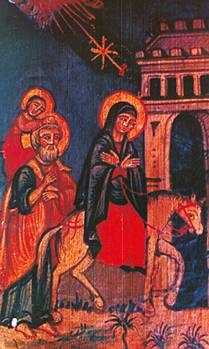|
Holy
Family
INTRODUCTION
Moved
by the spirit of prophecy, Hosea foresaw the flight from Bethlehem
where there was no safe place for the Christ Child to lay
his head, and the eventual return of the holy refugees from
their sanctuary in Egypt, where Jesus had found a place in
the hearts of the Gentiles, when he uttered God's words: "Out
of Egypt have I called My Son". (Hosea 11: 1)

An icon showing the flight of the Holy Family to Egypt
- Coptic Museum |
In
the Book of Isaiah, the prophet provides us with a divinely
inspired prediction of the effect the holy Infant was to have
on Egypt and the Egyptians: "Behold,
the Lord rides on a swift cloud, and will come into Egypt,
and the idols of Egypt will totter at His Presence, and the
heart of Egypt will melt in the midst of It". (Isaiah
19: 1)
The
authority of the Old Testament prophecy, which portended the
crumbling of idols wherever Jesus went, further foreshadowed
the singular blessing to be bestowed upon Egypt, for its having
been chosen as the Holy Family's haven, and upon its people
for having been the first to experience Christ's miraculous
influence.
God's
message, also delivered through the prophetic utterance of
Isaiah, "Blessed be Egypt, My People"
(Isaiah 19: 25), was an anticipation of the coming
of St. Mark to egypt, where the Gospel he preached took firm
root in the first decades of Christianity.
For
Isaiah goes on to prophecy: "In that
day there will be an altar to the Lord in the midst of the
land of Egypt; and a Pillar to the Lord, at its border. And
it will be for a sign and for a witness to the Lord of hosts
in the land of Egypt". (Isaiah 19: 19 & 20).
According
to the traditions of the Coptic Church, 'the altar' mentioned
is that of the Church of the Virgin Mary in Al-Muharraq Monastery,
a site where the Holy Family settled for a period of more
than six months. The altar-stone was the
|

|
'bed'
upon which the Infant Saviour lay. AI-Muharraq Monastery is
located "in the midst of the land of Egypt" .... standing
at its exact geographical centre. As for the "pillar at its
borders .... which will be for a sign and for a witness..."
The Patriarchal See of the Apostolic Church in Egypt, established
by St Mark himself, is situated in Alexandria, on Egypt's
northern borders.
The
prophecy continues, "Then the Lord will
be known to Egypt, and the Egyptians will know the Lord in
that day and will make sacrifice and offering". (Isaiah
19: 21). As Christianity in Egypt spread, churches were built
throughout the length and breadth of the land, and the sites
chosen were, primarily, those which, had been visited and
blessed by the Holy Family's sojourns. The New Testament records
the fulfilment of these Old Testament prophecies as they unfold
in their historical sequence.
"
..... behold, an angel of the Lord appeared to Joseph in a
dream, saying, Arise, take the young Child and His Mother,
flee to Egypt, and stay there until I bring you word, for
Herod will seek the young Child to destroy Him ".
(Matthew 2:13)
Joseph
complied. A donkey was fetched for the gentle Mother, still
so young in years, to ride with her new-born Child in Her
arms. And so they set out from Bethlehem on their pre-destined
journey, the hardened old carpenter, who was Mary's betrothed,
striding ahead, leading the donkey by its leash into the untracked
paths of a wilderness dark as the desert nights, and unending
as the months of never ending horizons.
It
was an arduous journey fraught with hazard every step of the
way. In those far-off days, there were three routes which
could be followed by travellers traversing Sinai from Palestine
to Egypt, a crossing which was usually undertaken in groups,
for without the protection of well organized caravans, the
ever present dangers - even along these known and trodden
paths- were ominously forbidding.
But,
in their escape from the infanticidal fury of King Herod,
the Holy Family - understandably - had to avoid the beaten
tracks altogether, and to pursue unknown paths, guided by
God and His Angel. They picked their way, day after day, through
hidden valleys and across uncharted plateaus in the (then)
rugged wastelands of Sinai, enduring the scorching heat of
the sun by day and the bitter cold of the desert nights, protected
from the threat of wild beasts and savage tribesmen. Their
daily sustenance was miraculously provided, the all too human
fears of the young Mother for her Infant were allayed by her
faith.
And
so they arrived, at last, safely, for God had pre-ordained
that Egypt should be the refuge for the One who was to bring
the message of peace and love to mankind.
The
tortuous trails they followed in their passage across Sinai,
and their subsequent travels within Egypt, are chronicled
by Pope Theophilus, 23rd Patriarch of Alexandria (384 - 412
AD). He testifies, in his celebrated annals, that after long
prayers, on the eve of the 6th of Hathor (the Coptic month
corresponding roughly with November), the Holy Virgin appeared
to him and, after relating the details of the Holy Family's
journey asked him to record all the information.
|
|